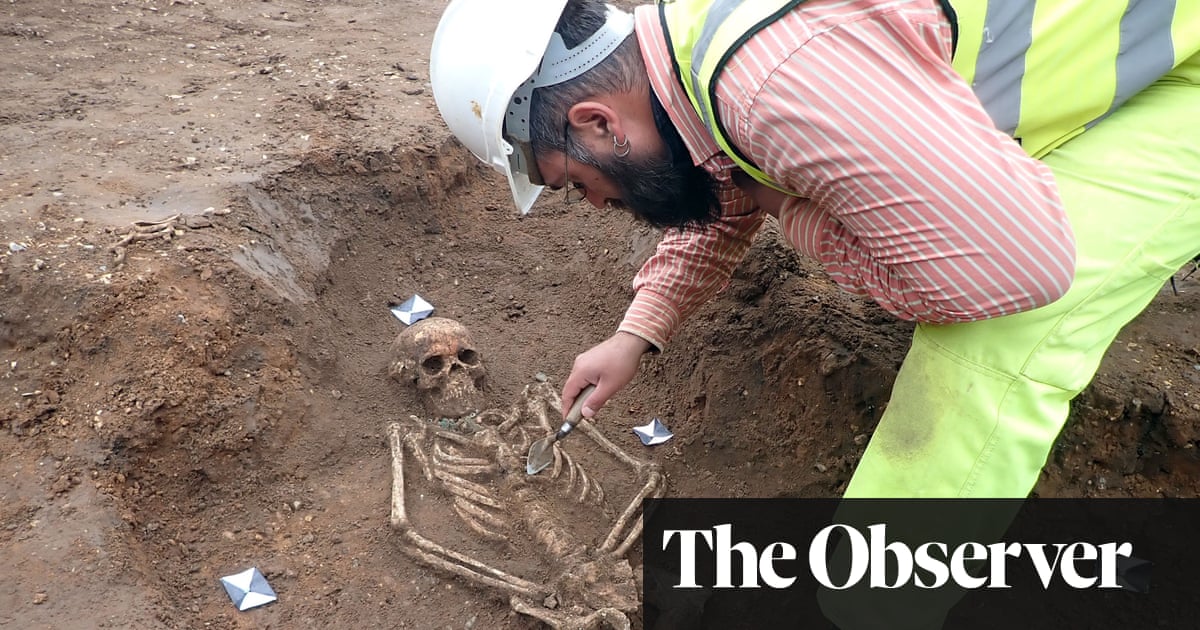
An early medieval cemetery excavated under student housing at Cambridge University has been described as “one of the most exciting finds in Anglo-Saxon archeology since the 19th century”.
King’s College discovered the “extensive” cemetery, with more than 60 graves, after demolishing a group of 1930s buildings that had recently housed graduates and staff in the west of the city to make way for more modern halls.
About 200 objects in the tombs, including bronze brooches, bead necklaces, swords, short knives, pottery and glass flasks, have been systematically uncovered. Most date from the early Anglo-Saxon period (ca.400-650 AD), although evidence has also been found of Iron Age structures and Roman earthworks.
Dr. Caroline Goodson, who teaches early medieval history at King’s, said the human remains they found were remarkably “well-preserved.” “The alkaline soil, which is typical here, has not broken down the bones.”
This is important because it will allow archaeologists to apply very modern scientific techniques to reveal the diet and DNA of the dead, allowing for analysis of migration and family relationships.

Goodson said excavators were “surprised” to find so many graves and such an extensive early medieval burial site, surrounded by Roman ditches and so close to the remains of Roman Cambridge. According to Bede’s Church History, written in the eighth century, Cambridge – like many other Roman cities – was abandoned when the Romans withdrew their forces from England in the fifth century. “We already know that Cambridge was not completely abandoned. But what we are seeing now is a larger and clearer picture of life in the post-Roman settlements. “
Goodson speculates that the people living in Cambridgeshire were a mix of descendants of earlier Roman populations and recent migrants to Britain from the continent, living in a post-imperial world.
Excavation site
“They don’t live like the Romans anymore, they eat differently, dress differently and find different ways to exploit the land. They change the way they live in a period of significant fluidity. “
Some finds raise questions about the emotional ties that people felt at the time of the funerals with the Romans who lived in Cambridge before them. In one tomb, archaeologists found a body buried with what appears to be a late Roman piece of glass in the shape of a small vessel for storing wine.
“It looks like a classic Roman object that is being reused as burial goods in a post-Roman context.” Another tomb looks like a typical late Roman burial from the fifth century, suggesting that there has been continuity of use of the cemetery from Roman times. “That would be very interesting,” said Goodson.
So far, archaeologists have not found ‘strong evidence’ that people who lived in the sixth century still chose to bury their dead near late Roman tombs, but few burial sites of this size have been scientifically excavated using of modern methods and technologies, such as advanced radiocarbon. dating techniques and isotope analysis.

“It would be great to say very clearly – and for that we need a wide array of carbon-14 dates – that people have been using this site from the fifth to the seventh century,” Goodson says. “We can see that the burying of the dead and the treatment of their bodies is particularly important to the living in a way that is unlike elsewhere in the post-Roman world.” That points to a different world view and a different “cosmology”: “It is a new form of commemoration.”
She hopes to find out if anyone in the cemetery died from the Justinian plague, a pandemic that raged across Europe in the 540s.
“I’m really curious if it was also in Cambridge and to what extent that relates to what else was going on.”